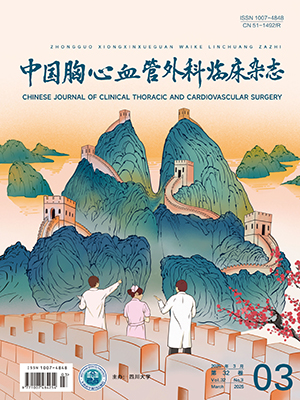| 1. |
Santhanam H, Yang L, Chen Z, et al. A meta-analysis of transcatheter device closure of perimembranous ventricular septal defect. Int J Cardiol, 2018, 254: 75-83.
|
| 2. |
Ou-Yang WB, Wang SZ, Hu SS, et al. Perventricular device closure of perimembranous ventricular septal defect: effectiveness of symmetric and asymmetric occluders. Eur J Cardiothorac Surg, 2017, 51(3): 478-482.
|
| 3. |
Schreiber C, Vogt M, Kühn A, et al. Periventricular closure of a perimembranous VSD: treatment option in selected patients. Thorac Cardiovasc Surg, 2012, 60(1): 78-80.
|
| 4. |
Quansheng X, Silin P, Zhongyun Z, et al. Minimally invasive perventricular device closure of an isolated perimembranous ventricular septal defect with a newly designed delivery system: preliminary experience. J Thorac Cardiovasc Surg, 2009, 137(3): 556-559.
|
| 5. |
Gao Z, Wu Q, Zhao T, et al. A minimally invasive technique for occluding large muscular ventricular septal defects in infants. Cardiology, 2014, 127(3): 196-202.
|
| 6. |
Yang XC, Liu DB. Minimally invasive perventricular device closure of ventricular septal defect: a comparative study in 80 patients. Chin Med Sci J, 2014, 29(2): 98-102.
|
| 7. |
Thanopoulos BD, Tsaousis GS, Karanasios E, et al. Transcatheter closure of perimembranous ventricular septal defects with the Amplatzer asymmetric ventricular septal defect occluder: preliminary experience in children. Heart, 2003, 89(8): 918-922.
|
| 8. |
Xing Q, Wu Q, Shi L, et al. Minimally invasive transthoracic device closure of isolated ventricular septal defects without cardiopulmonary bypass: long-term follow-up results. J Thorac Cardiovasc Surg, 2015, 149(1): 257-264.
|
| 9. |
Pinto RJ, Dalvi BV, Sharma S. Transcatheter closure of perimembranous ventricular septal defects using amplatzer asymmetric ventricular septal defect occluder: preliminary experience with 18-month follow up. Catheter Cardiovasc Interv, 2006, 68(1): 145-152.
|
| 10. |
Xing Q, Pan S, An Q, et al. Minimally invasive perventricular device closure of perimembranous ventricular septal defect without cardiopulmonary bypass: multicenter experience and mid-term follow-up. J Thorac Cardiovasc Surg, 2010, 139(6): 1409-1415.
|
| 11. |
Xing Q, Wu Q, Pan S, et al. Transthoracic device closure of ventricular septal defects without cardiopulmonary bypass: experience in infants weighting less than 8 kg. Eur J Cardiothorac Surg, 2011, 40(3): 591-597.
|
| 12. |
Yang R, Sheng Y, Cao K, et al. Transcatheter closure of perimembranous ventricular septal defect in children: safety and efficiency with symmetric and asymmetric occluders. Catheter Cardiovasc Interv, 2011, 77(1): 84-90.
|
| 13. |
Chen ZY, Lin BR, Chen WH, et al. Percutaneous device occlusion and minimally invasive surgical repair for perimembranous ventricular septal defect. Ann Thorac Surg, 2014, 97(4): 1400-1406.
|
| 14. |
Yin S, Zhu D, Lin K, et al. Perventricular device closure of congenital ventricular septal defects. J Card Surg, 2014, 29(3): 390-400.
|
| 15. |
Chen H, Liu J, Gao W, et al. Late complete atrioventricular block and tricuspid regurgitation after percutaneous closure of a perimembranous ventricular septal defect. J Thorac Cardiovasc Surg, 2010, 140(3): e60-e61.
|
| 16. |
戴柯, 李奋, 孙康, 等. 全生物可降解型房间隔缺损封堵器封堵猪房间隔缺损的实验研究. 临床儿科杂志, 2010, 28(4): 375-379.
|
| 17. |
朱玉峰. 生物可完全降解房间隔缺损封堵器的研制及动物实验研究. 第二军医大学, 2010. 5.
|
| 18. |
Liu SJ, Peng KM, Hsiao CY, et al. Novel biodegradable polycaprolactone occlusion device combining nanofibrous PLGA/collagen membrane for closure of atrial septal defect (ASD). Ann Biomed Eng, 2011, 39(11): 2759-2766.
|
| 19. |
Xie ZF, Wang SS, Zhang ZW, et al. A novel-design poly-l-lactic acid biodegradable device for closure of atrial septal defect: long-term results in swine. Cardiology, 2016, 135(3):179-187.
|
| 20. |
Mullen MJ, Hildick-Smith D, De Giovanni JV, et al. BioSTAR Evaluation STudy (BEST): a prospective, multicenter, phase I clinical trial to evaluate the feasibility, efficacy, and safety of the BioSTAR bioabsorbable septal repair implant for the closure of atrial-level shunts. Circulation, 2006, 114(18): 1962-1967.
|
| 21. |
Karagianni A, Abrahamsson P, Furenäs E, et al. Closure of persistent foramen ovale with the BioSTAR biodegradable PFO closure device: feasibility and long-term outcome. Scand Cardiovasc J, 2011, 45(5): 267-272.
|
| 22. |
Baspinar O, Kervancioglu M, Kilinc M, et al. Bioabsorbable atrial septal occluder for percutaneous closure of atrial septal defect in children. Tex Heart Inst J, 2012, 39(2): 184-189.
|




